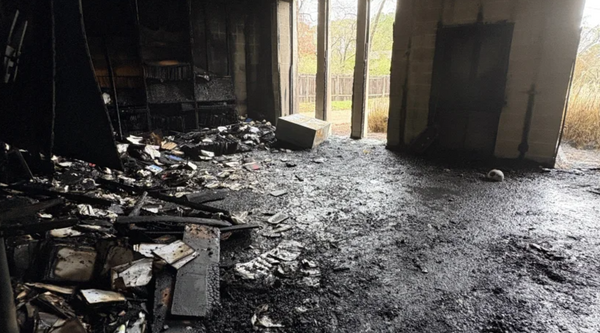The last remaining member of a group of students famed for their dauntless raid to reclaim the Stone of Destiny and bring it back to Scotland died at the age of 97 this week.
Renowned KC and defence lawyer Ian Hamilton passed away peacefully on Monday evening in North Connel, Argyll, with his wife Jeannette and family at his side.
Ian was one of four students who stole the ancient Stone of Scone from under the Coronation Chair in Westminster Abbey on Christmas Day, 1950.
Hamilton, born in Paisley in 1925, was a law student at Glasgow University when he took part in the daring break-in.
Ian later became a QC (Queen’s Counsel, now King’s Counsel) and remained politically active throughout his life, joining Labour before running for the SNP in the 1994 and 1999 elections.
He was the last surviving member of the group, with fellow independence activists Gavin Vernon dying in 2004, teacher and political activist Kay Matheson in 2013, and Alan Stuart in 2019.
An extract from his book ‘Stone of Destiny: The True Story’ read: “I have had many other adventures since. Yet this was the first and most important one.
“It set the tone for my whole life.
“It taught me that non-conformity in thought and deed is the only vital life.
“The individual is more important than the mass. Any single person can change history.”
His son Stewart Hamilton said that his father had “lived a good life”, and that his family were “very proud of him” that he had “touched so many people”.
In tribute, Perthshire North MSP and deputy first minister John Swinney said: “I am terribly sorry to hear of the death of Ian Hamilton KC.
“Ian had a life of towering achievements.
“His courage and creativity in leading the return of the Stone of Destiny inspired a generation to believe in independence.
“My thoughts are with Ian’s family at this difficult time.”
Roddy Dunlop KC, dean of the faculty of advocates, said: “Ian was a formidable Advocate, a great friend to many, and a lovely man. It is thus with deep sorrow that we bid him farewell.”
In 1296, the Stone of Destiny was looted from Scone Abbey, near Perth, by English forces led by Edward I.
It was taken to Westminster Abbey and fitted inside the wooden throne upon which most subsequent English and British monarchs have been crowned.
Despite promises that it would be returned, including in the 1328 Treaty of Northampton, the stone lay undisturbed for six and a half centuries until four Scottish students, led by Hamilton, decided to bring it back.
At about 6am on Christmas Day 1950, Hamilton and his friends Alan Stuart, Kay Matheson and Gavin Vernon used a crowbar to break into the Abbey.
They retrieved the stone from inside the coronation chair, only for it to crash to the floor and break in two – although this damage could have been caused by a suffragettes’ bomb in 1914.
While loading the chunks into their borrowed Ford Anglia, they were approached by a policeman who allowed them to carry on after Hamilton and Matheson fell into an embrace, pretending to be lovers.
A manhunt was soon under way, with roadblocks across the Cheviot Hills closing the Scottish border for the first time in centuries.
While the English police expressed a keen interest in every northbound car, their Scottish counterparts took a different approach.
“Aye,” one said, “sure we’re looking for them, but no’ so damned hard that we’ll find them.”
Hamilton had in fact driven southeastwards and buried the stone in a wood near Rochester in Kent.
He then travelled to his parents’ home in Scotland.
“I’ve lost my watch in Westminster Abbey,” was his opening line. “Was it you?” exclaimed his mother in delight.
He later called into a central London police station to ask if the watch had been retrieved, but was given short shrift.
He hoped that the Earl of Mansfield, owner of Scone Palace, would take the stone.
As he was ushered in, Mansfield said: “Don’t tell me your name, it is better that I shouldn’t know it.”
After hearing him out, the peer announced that regrettably he could not get involved.
Hamilton begged him not to reveal his description to the police.
“Good heavens,” snapped his lordship. “Do you think I am an Argyll to betray a fellow Scotsman? I shall give them no description.”
A few weeks later, Hamilton and his colleagues retrieved the 152kg stone and drove it up to Scotland.
As they crossed the border, “we pulled back the coat that covered the stone, and each poured out a little of the wine of the country on to it, signifying its return to the Celtic people”.
He arranged for it to be repaired by a Glasgow builder called Bertie Gray but, fearing a change in public opinion, then had it wrapped in a Saltire and left in the ruins of Arbroath Abbey, where the 1320 declaration had been signed asking the Pope to recognise Scottish independence.
The stone was discovered three months later and returned to Westminster Abbey in February 1952.
Curiously no charges were brought against the four Scots for fear of making them martyrs, though Sir Hartley Shawcross, the attorney general, told MPs: “The clandestine removal of the stone from Westminster Abbey, and the manifest disregard for the sanctity of the abbey, were vulgar acts of vandalism which have caused great distress and offence both in England and Scotland.”
The move was also hailed by many as a triumph of Scottish nationalism and the stone was later returned to Scotland in 1996, to go on display at Edinburgh Castle.
The earliest origins of the Stone of Destiny are unknown, with many rumours citing either biblical or Scottish origins.
It has been used to crown countless Scottish, English and British monarchs over the years, and was last used in 1952 for the coronation of HM Queen Elizabeth II.
Also known as the Stone of Scone, a replica of the 152 kilogram relic can be seen on Moot Hill in the grounds of Scone Palace.
One legend of the stone suggests it is actually the biblical Jacob’s Pillow, which was taken by the prophet Jeremiah to Ireland, before an early Scottish king then took the stone across the Irish Sea to Argyll.
The legend also suggests the stone was taken by the missionary Columba when he visited Iona in 563AD.
A more recent geological survey of the stone, carried out when it was returned to Scotland at a conservation centre in Edinburgh in 1996, showed the sandstone used to make the stone had been quarried from the vicinity of Scone.
Over the years, it has been used in London, Scone, Iona and Dunadd.
It is understood Kenneth Macalpin, one of the earliest Scottish kings, was crowned on the Stone of Destiny in 841.
The last Scottish king to the crowned on the Stone of Destiny was John Balliol in 1292.
That year, the stone was taken by King Edward I of England, who built it into a coronation throne.
For over 700 years the stone and the coronation throne sat in St Edward the Confessor’s Chapel in London’s Westminster Abbey, with many English and British monarchs being crowned upon it. However, some also say monks hid the real Stone of Destiny from the English king after they heard he was marching towards Scone, which would mean the stone he took was a fake.
It remained in London and was used to crown English monarchs, and from 1707 onwards, British monarchs until its return to Scotland in 1996.
Speaking of the famous theft, Hamilton said: “When I lifted the stone in Westminster Abbey, I felt Scotland’s soul was in my hands.”
The Stone of Destiny will be moved from Edinburgh Castle to London temporarily for the coronation of King Charles III.
When Elizabeth II was crowned in 1953 at Westminster Abbey her throne sat above the stone, which is set to become the centrepiece of the new £26.5 million museum at Perth City Hall in 2024.
It was taken from its Scone home 724 years ago, but in December 2020 it was announced the iconic relic would return to Perthshire after the Commissioners for the Safeguarding of the Regalia made the decision on behalf of the Queen that it should be moved from Edinburgh Castle.







